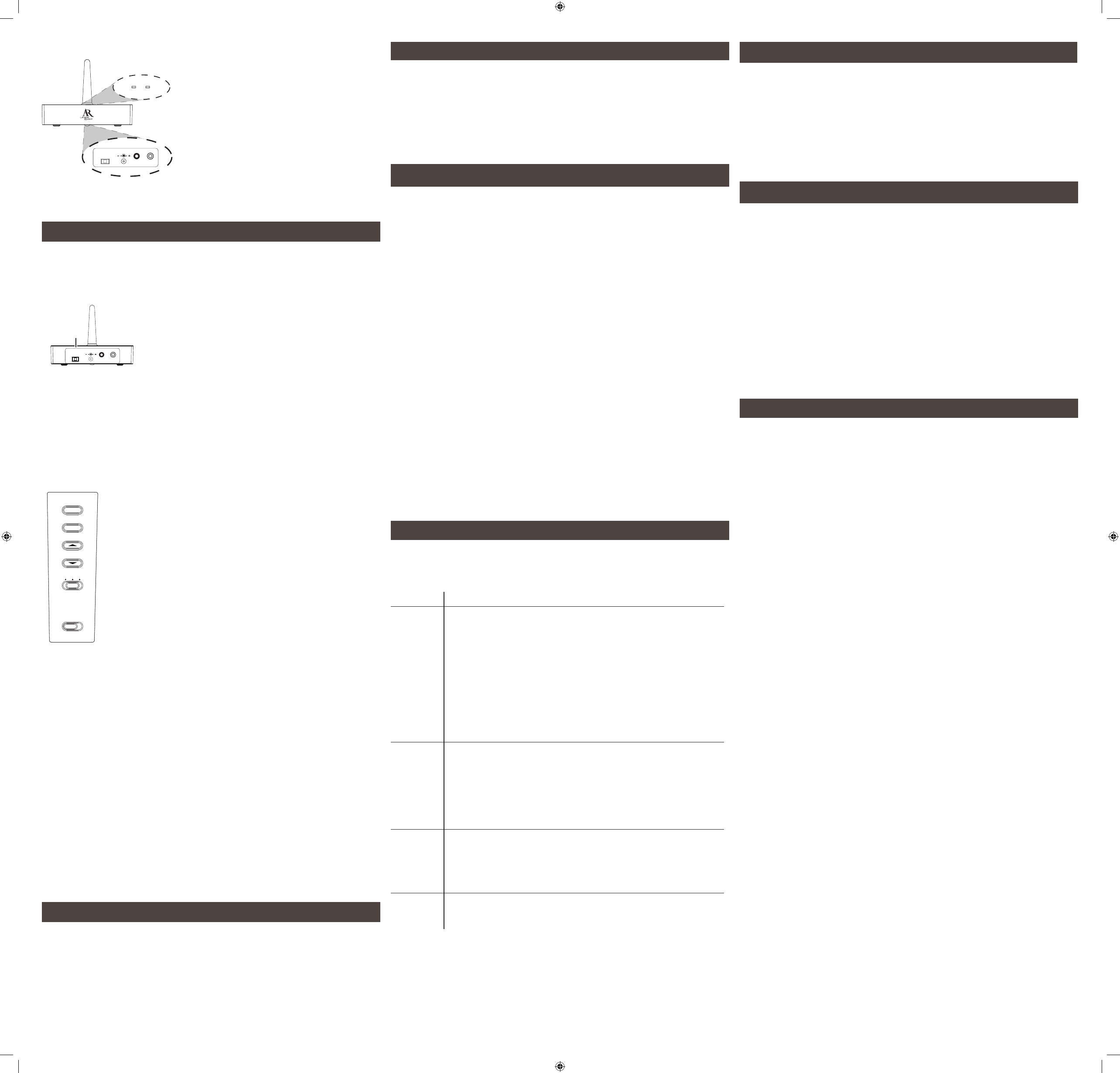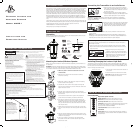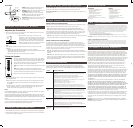
About Variable-Level Audio Outputs:
A variable-level output, such as a headphone jack or certain RCA-type outputs,
provides an audio signal that changes with the volume level set on the audio source.
As the volume of the audio source is adjusted up and down, so is the audio signal
strength sent to the transmitter. This can affect the quality of sound generated by the
speaker, and may require an adjustment of the volume level of the audio source to
produce a signal strong enough for the transmitter.
Hint: On most bookshelf-type or compact stereo systems, inserting a headphone
plug into the headphone jack results in automatic cutoff of the regular, or hard-wired
speakers.
Hint: Most TVs, regardless of age or price, have variable outputs. If you are unsure
which of your TV audio outputs is fi xed, refer to the TV instruction manual. Some
TVs have outputs that can switch between variable and fi xed. When given a choice,
fi xed is always recommended.
Troubleshooting
The following troubleshooting guide takes you through some of the more common
problems associated with the installation and/or operation of a wireless system. If the
problem persists, please call toll-free at 1-800-732-6866 or visit www.araccessories.com.
Issue: Cause and solution:
No sound • Check that the transmitter AC power adapter is fully inserted into the wall outlet and
the power cord from the AC adapter is fi rmly connected to the transmitter power
input jack.
• Confi rm that the speaker is turned on and tuned to the transmitter—
the indicator light on the front of the speaker should be solid blue (not blinking).
• If the speaker is on a switched outlet, make sure the outlet is on.
• Check that the audio source component (stereo, MP3 player, etc.) is turned on and
transmitting sound as it normally should.
• Make sure the volume on your audio source is turned up.
• Check that the speaker volume is turned up.
• If you are using a Tape 2 Monitor output from your receiver/amp as the audio
output, check that you have pressed the Tape Monitor/Tape 2 button on the front of
the receiver. This will turn on the Tape 2 outputs, which may not have been active.
No sound/
distortion/
static
• Check that the speaker’s indicator light is solid blue (not blinking).
• Change the position of the channel select switch (1, 2 or 3) to change the operating
frequency. Then press the Auto Scan button on the bottom of the speaker to make
the speaker retune.
• Change the location of the transmitter. Place it as high and away from obstructions
as possible. Avoid placing the transmitter directly on top of or behind a TV.
• Move the transmitter closer to the speaker. Sending the signal through certain
materials, such as glass, tile, and metal, can decrease the effective transmitting
distance of the system.
Bulb doesn’t
light
• If the lantern/speaker is on a switched outlet, make sure the outlet is on.
• Make sure the light on/off switch on the bottom of the lantern/speaker is switched
on.
• Make sure the bulb hasn’t burned out. Try a new bulb in the lantern/speaker.
• If the above solutions don’t work, turn off power to the outlet at the circuit box and
make sure the lantern/speaker is wired correctly.
Circuit breaker
trips when you
turn on the
lantern
• The lantern/speaker is probably wired incorrectly. Turn off power to the outlet at the
circuit box and rewire the lantern/speaker, making sure to match the black to black
wire, white to white, and ground to ground.
More Helpful Information
About Fixed-Level Audio Outputs
A fi xed-level, or line-level, audio output is considered ideal since it provides an audio
signal unchanged by adjustments to the audio source volume control.
Hint: Fixed-level audio outputs from stereo receivers/amps will typically be
designated as Tape (or Record) outputs or DVR/DVD-R audio output connections.
Fixed-level outputs from TVs are usually marked as ‘Constant,’ ‘Fixed,’ or ‘Select.’ If they
are not marked as such, they are probably variable outputs (see “About Variable-Level
Audio Outputs” below). Outputs from DVD players are almost always fi xed.
Hint: When connecting to the audio outputs of a DVD player, remember that the DVD
player must be showing a TV channel for sound to be produced.
Trademark(s) ® Registered www.araccessories.com MADE IN CHINA AW851 US IB 00
12 Month Limited Warranty
Specifi cations
Transmitter
• Omni-directional 900MHz broadcast
• Effective transmitting range:
up to 150 ft. (45m)*
• Phase-locked loop circuitry (PLL)
• Automatic level control (ALC)
• 3 selectable broadcast frequencies
• Stereo audio input
Speaker
• Push-button, auto-lock tuning
• 2-way acoustic design:
2” tweeter, 3” woofer
• 5 Watt RMS internal amplifi er
• Omni-directional sound
• Frequency response: 40Hz - 15kHz
• Left/Mono/Right switch
• Operates using AC outlet box (requires
installation)
*Maximum range; results may vary according to
environment.
Audiovox Electronics Corporation (the “Company”) warrants to the original retail
purchaser of this product that should this product or any part thereof, under normal
use and conditions, be proven defective in material or workmanship within 12 months
from the date of original purchase, such defect(s) will be repaired or replaced (at
the Company’s option) without charge for parts and repair labor. To obtain repair or
replacement within the terms of this Warranty, the product along with any accessories
included in the original packaging is to be delivered with proof of warranty coverage
(e.g. dated bill of sale), specifi cation of defect(s), transportation prepaid, to the
Company at the address shown below. Do not return this product to the Retailer.
This Warranty is not transferable and does not cover product purchased, serviced
or used outside the United States or Canada. The warranty does not extend to
the elimination of externally generated static or noise, to costs incurred for the
installation, removal or reinstallation of the product.
The warranty does not apply to any product or part thereof which, in the opinion of
the company, has suffered or been damaged through alteration, improper installation,
mishandling, misuse, neglect, accident or exposure to moisture. This warranty does
not apply to damage caused by an AC adapter not provided with the product, or by
leaving non-rechargeable batteries in the product while plugged into an AC outlet.
THE EXTENT OF THE COMPANY’S LIABILITY UNDER THIS WARRANTY IS LIMITED TO
THE REPAIR OR REPLACEMENT PROVIDED ABOVE AND, IN NO EVENT, SHALL THE
COMPANY’S LIABILITY EXCEED THE PURCHASE PRICE PAID BY PURCHASER FOR
THE PRODUCT.
This Warranty is in lieu of all other express warranties or liabilities. ANY IMPLIED
WARRANTIES, INCLUDING ANY IMPLIED WARRANTY OF MERCHANTABILITY OR
FITNESS FOR A PARTICULAR PURPOSE, SHALL BE LIMITED TO DURATION OF THIS
WARRANTY. ANY ACTION FOR BREACH OF ANY WARRANTY HEREUNDER, INCLUDING
ANY IMPLIED WARRANTY, MUST BE BROUGHT WITHIN A PERIOD OF 24 MONTHS
FROM THE DATE OF ORIGINAL PURCHASE. IN NO CASE SHALL THE COMPANY BE
LIABLE FOR ANY CONSEQUENTIAL OR INCIDENTAL DAMAGES WHATSOEVER. No
person or representative is authorized to assume for the Company any liability other
than expressed herein in connection with the sale of this product.
Some states/provinces do not allow limitations on how long an implied warranty lasts
or the exclusion or limitation of incidental or consequential damage so the above
limitations or exclusions may not apply to you. This Warranty gives you specifi c legal
rights and you may also have other rights which vary from state/province to state/
province.
U.S.A.:Audiovox Electronics Corp., 150 Marcus Blvd., Hauppauge, New York 11788
CANADA: Audiovox Return Center, c/o Genco, 6685 Kennedy Road, Unit #3 Door 16,
Mississauga Ontario L5T 3A5
1. Press the Speaker On/Off button on the right side of the speaker
to turn it on. The indicator light on the front of the speaker blinks
while the speaker is tuning to the transmitter. The indicator light
turns solid blue when the speaker is tuned to the transmitter—you
should hear sound coming from the speaker now.
Note: If the speaker is on a switched outlet, make sure the outlet is
on.
Note: If the speaker is not tuned or if the transmitter is not
connected properly, the indicator light will continue blinking. If this
occurs, please see the troubleshooting section of this manual.
2. Adjust the volume on the speaker as desired.
3. Set up the speaker for mono or stereo operation using the switch on the right side
of the AW851 speaker.
a) Monaural operation: The monaural mode (mono) is recommended when using a
single AW851 by itself. For monaural operation, set the L/M/R switch to “M” on
the speaker.
b) Stereo operation: You need an additional AW851 speaker for the stereo option.
Set the L/Mono/R switch to “L” on the speaker located to the left from the
listener, and set the other speaker to the “R” position.
Notes:
A single AW851 transmitter can send its signal to more than two speakers. All you need
to do is tune the speakers to the single transmitter.
The speaker automatically retunes if it loses the transmitter’s signal. You can also press
the Auto Scan button on the bottom of the speaker to retune the speaker at any time.
The transmitter turns off automatically if there is no audio signal present for a prolonged
period.
Interference in the form of static and/or distortion can sometimes be heard. If this
occurs, confi rm the transmitter/speaker adjustments and indicators. If the problem
persists, refer to the Troubleshooting section of this manual.
Pairing the Speaker System
2. Set the channel select switch on the back of the
transmitter to one of the transmitter’s three broadcast
frequencies: 1, 2 or 3. If you experience poor reception
or interference, try choosing a different frequency by
moving the channel select switch to another position.
When the transmitter is receiving an audio signal and is
ready, the SIGNAL indicator turns solid green.
Turning the Speaker Off
1. Press Speaker On/Off button on the bottom of the speaker to turn the speaker off.
2. Confi rm that the speaker is off by verifying that the indicator light on the speaker’s
front panel is no longer illuminated.
DC IN
CHANNEL
1 2 3
R AUDIO L
IN
Channel
select
switch
Adjusting the Transmitter
1. Turn on your audio source (for example, A/V receiver, MP3 player, stereo, etc.) and
play music at a normal listening volume.
Note
If the SIGNAL indicator on the transmitter does not turn on, please check the
following:
- Confi rm the transmitter AC power adapter is securely connected.
- Confi rm the cable from the transmitter is securely connected to the audio source
output (MP3 player, A/V receiver, etc.).
- Confi rm the audio source is playing audio and is turned up.
Tuning the Speaker
Turning the Lamp On and Off
To turn the lamp on: Put the Light On/Off switch on the bottom of the speaker in the
on position. If the lamp is on a switched outlet, make sure the outlet is on.
To turn the lamp off: Put the Light On/Off switch on the bottom of the speaker in the
off position.
Transmitter
SIGNAL indicator lights green when the audio is
present and the transmitter is broadcasting
POWER indicator lights when the transmitter is on
CHANNEL 1 2 3 lets you fi nd the best
transmission frequency for your environment
DC IN jack receives the small round end of the
included 12V 200mA AC power adapter
AUDIO IN (R / L) connects to your sound source
using one of the connection options shown on
the next pages
Back panel
DC IN
CHANNEL
1 2 3
R AUDIO L
IN
SIGNAL POWER
Top panel
FCC Statement
This equipment has been tested and found to comply with the limits for a Class B digital device, pursuant to part
15 of the FCC Rules. These limits are designed to provide reasonable protection against harmful interference in a
residential installation. This equipment generates, uses, and can radiate radio frequency energy and, if not installed
and used in accordance with the instructions, may cause harmful interference to radio communication. However,
there is no guarantee that interference will not occur in a particular installation. If this equipment does cause
harmful interference to radio or television reception, which can be determined by turning the equipment off and
on, the user is encouraged to try to correct the interference by one or more of the following measures:
• Reorient or relocate the receiving antenna.
• Increase the separation between the equipment and receiver.
• Connect the equipment into an outlet on a circuit different from that to which the receiver is connected.
• Consult the dealer or an experienced radio/TV technician for help.
FCC Regulations state that unauthorized changes or modifi cations to this equipment may void the user’s authority
to operate it.
Industry Canada Regulatory Information
Operation is subject to the following two conditions: (1) this device may not cause harmful interference and (2)
this device must accept any interference received, including interference that may cause undesired operation.
The user is cautioned that this device should be used only as specifi ed within this manual to meet RF exposure
requirements. Use of this device in a manner inconsistent with this manual could lead to excessive RF exposure
conditions.
This Class B digital apparatus complies with Canadian ICES-003.
FCC / IC Information
Auto Scan
Volume
Volume
L Mono R
Light
On/O
On/O
Speaker




